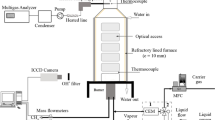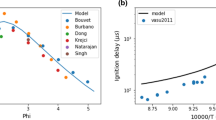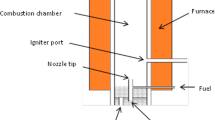Abstract
This study deals with the formation of carbon dioxide (CO2) after combustion process and dispersion in a closed area. The formation and dispersion of CO2 were numerically simulated and validated by experiment. Ethanol (C2H5OH) was chosen as a fuel for the combustion process. Numerical simulations were carried out by using Reynolds averaged Navier–Stokes (RANS) approach with k-ε and k-ω turbulent models. The combustion process was simulated using two methods. Species transport with chemical reactions was the first method, and the second method was the nonpremix combustion model based on the mixture fraction theory. There were done some sensitivity studies on the influence of the time step size and a resolution of computational grid. Results from numerical simulations were validated by experimental measurements, where the CO2 concentration was measured by the non-dispersive infrared (NDIR) sensor at four points.
Similar content being viewed by others
References
Gee, I., Monitoring Indoor Air Pollution, Indoor Build. Envir., 2001, vol. 10, pp. 123–124.
Xing, H., Hatton, A., and Awbi, H.B., A Study of the Air Quality in the Breathing Zone in a Room with Displacement Ventilation, Build. Envir., 2001, vol. 36, pp. 809–820.
Austin, J., Brimblecombe, P., and Sturges, W., Air Pollution Science for the 21st Century, Amsterdam: Elsevier, 2002.
Nazaroff, W. and Cass, G.R., MathematicalModeling of Chemically Reactive Pollutants in Indoor Air, Envir. Sci. Technol., 1986, vol. 20, pp. 924–934.
Hyun, S. and Kleinstreuer, C., Numerical Simulation of Mixed Convection Heat and Mass Transfer in a Human Inhalation Test Chamber, Build. Envir., 2001, vol. 44, pp. 2247–2260.
Wang, Y., Zhao, F., Kuckelkorn, J., Liu, D., Liu, J., and Zhang, J., Classroom Energy Efficiency and Air Environment with Displacement Natural Ventilation in a Passive Public School Building, Energy Build., 2014, vol. 70, pp. 258–270.
Jovanovic, M., Vucicevic, B., Turanjanin, V., Zivkovic, M., and Spasojevic, V., Investigation of Indoor and Outdoor Air Quality of the Classrooms at a School in Serbia, Energy, 2014, vol. 1, pp. 42–48.
Salthammer, T., Schripp, T., Wientzek, S., and Wensing, M., Impact of OperatingWood-Burning Fireplace Ovens on Indoor Air Quality, Chemosphere, 2014, vol. 103, pp. 205–211.
Zhao, K., Zhou, X., and Zhao, B., Cooking Generated Particles’ Impact on Indoor Air Quality of University Cafeteria, Build. Simul., 2010, vol. 3, pp. 15–23.
Hurnik, M., Blaszczok, M., and Popiolek, Z., Air Distribution Measurement in a Room with a Sidewall Jet: A 3D Benchmark Test for CFD Validation, Build. Envir., 2015, vol. 93, pp. 319–330.
Nielsen, P.V., Fifty Years of CFD for Room Air Distribution, Build. Envir., 2015, vol. 91, pp. 78–90.
Penenko, V.V. and Tsvetova, E.A., Mathematical Models for the Study of Interactions in the System Lake Baikal–Atmosphere of the Region, J. Appl. Mech. Techn. Phys., 1999, vol. 40, pp. 308–316.
Zhuang, R., Li, X., and Tu, J., CFD Study of the Effects of Furniture Layout on Indoor Air Quality under Typical Office Ventilation Schemes, Build. Simul., 2014, vol. 7, pp. 263–275.
Li, M., Zhao, B., Tu, J., and Yan, Y., Study on the Carbon Dioxide Lockup Phenomenon in Aircraft Cabin by Computational Fluid Dynamics, Build. Simul., 2015, vol. 8, pp. 431–441.
Jiang, Z., Haghighat, F., and Chen, Q., Ventilation Performance and Indoor Air Quality in Workstations under Different Supply Air Systems: A Numerical Approach, Indoor Build. Envir., 1997, vol. 6, pp. 160–167.
Saha, S., Guha, A., and Roy, S., Experimental and Computational Investigation of Indoor Air Quality Inside Several Community Kitchens in a Large Campus, Build. Envir., 2012, vol. 52, pp. 177–190.
Gao, N. and Niu, J., CFD Study on Micro-Environment around Human Body and Personalized Ventilation, Build. Envir., 2004, vol. 39, pp. 795–805.
Ricciardi, L., Prévost, C., Bouilloux, L., and Sestier-Carlin, R., Experimental and Numerical Study of Heavy Gas Dispersion in a Ventilated Room, J. Hazard. Mater., 2008, vol. 152, pp. 493–505.
Sklavounos, S. and Rigas, F., Validation of Turbulence Models in Heavy Gas Dispersion over Obstacles, J. Hazard. Mater., 2008, vol. A108, pp. 9–20.
Marinov, N., A Detailed Chemical Kinetic Model for High Temperature Ethanol Oxidation, Int. J. Chem. Kin., 1999, vol. 31, pp. 183–220.
Launder, B.E. and Spalding, D.B., The Numerical Computation of Turbulence Flows, Comput.Meth. Appl. Mech. Eng., 1974, vol. 3, pp. 269–289.
Wilcox, D.C., Reassessment of the Scale-Determining Equation for Advanced Turbulence Models. AIAA J., 1988, vol. 26, pp. 1299–1310.
Hjertager, B.H. and Magnussen, B.F., On Mathematical Models of Turbulent Combustion with Special Emphasis on Soot Formation and Combustion, The 6th Int. Symposium on Combustion, Pittsburgh: The Combustion Institute, 1977.
Author information
Authors and Affiliations
Corresponding author
Rights and permissions
About this article
Cite this article
Korinek, T., Frana, K. Formation and dispersion of CO2 after combustion in closed area. J. Engin. Thermophys. 26, 532–541 (2017). https://doi.org/10.1134/S1810232817040087
Received:
Published:
Issue Date:
DOI: https://doi.org/10.1134/S1810232817040087




